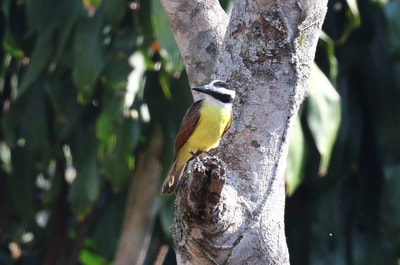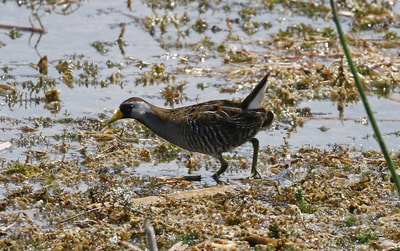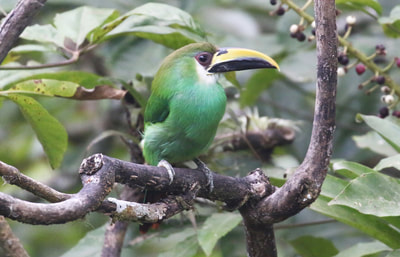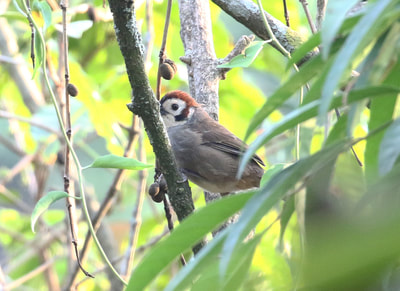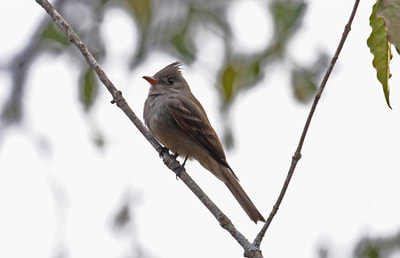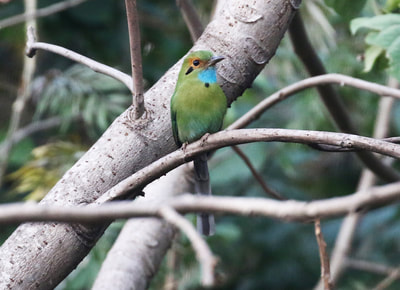2nd March
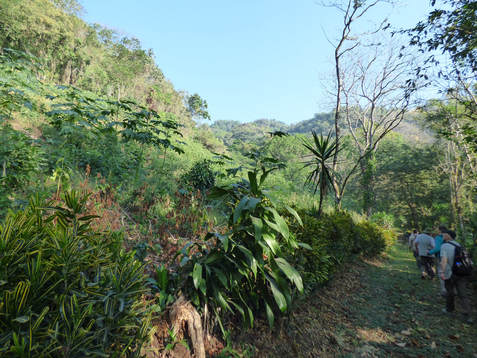
We arose early again and had a coffee [delicious] and then took a walk around the lower grounds of Los Tarrales comprising lowland forest, before breakfast. This area also had many stands of bamboo like the one where we saw the Mottled Owl yesterday, plus plantations of coffee. It became pretty warm fairly quickly and we saw plenty of raptors, including a King Vulture drifting over, which dwarfed the many Turkey and Black Vultures. We also had Grey Hawk and Short-tailed Hawk, and Northern Crested Caracara. The rich habitat abounded with birds. Hummers comprised Violet Sabrewing, and Cinnamon, Azure-crowned and Blue-tailed Hummingbirds. Two Turquoise-browed Motomots were great to see, as was a Rufous-breasted Spinetail. New on my list was a Greenish Elaenia. There were plenty of Flycatchers too - 2 not mentioned before were Tropical and Western Kingbirds, and then a run of four new birds for the trip - Brown-crested Flycatcher, Masked Tityra, Rose-throated Becard and Spot-breasted Wren. Back up in the air, parrots moved through or over the tree tops in the form of Orange-chinned Parakeet, Yellow-naped Amazon {IOC name - aka Yellow-naped Parrot}, Orange-fronted Parakeet and Pacific Parakeet. After a bird-filled couple of hours we returned to the centre and had our breakfast.
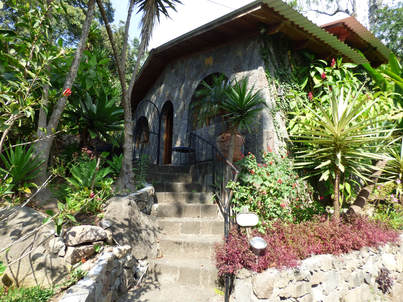 Anne & my bungalow at the Posada
Anne & my bungalow at the Posada
After breakfast we set off on the journey to our next destination by Lake Atitlan, in the town of Santiago de Atitlan on the south shore of the lake. Our accommodation was the lovely Posada de Santiago, set back off the main street via a narrow entrance. Atitlan means "at the water" in the old Aztec language of Nahuatl. The lake lies in a huge old volcanic crater and is the deepest lake in Central America, and is regarded as one of the most scenic in the world, surrounded as it is, by verdant forested old volcanic cones. On reaching the lake we stopped at a place called San Lucas Toliman where we had a chance of seeing Slender Sheartail, a hummingbird which occurs between S. Mexico and El Salvador. We walked a small trail down the the shoreline but failed to find our target. Nevertheless the small bay, viewed from a wooden jetty, gave us Blue-winged Teal, Lesser Scaup, Ring-necked Duck, Ruddy Duck, Green Heron, Neotropic Cormorant, Pied-billed Grebe, American Coot, Common Gallinule, Spotted Sandpiper and an obliging Sora. Passerines flitted about in the adjacent reeds and undergrowth, the best being a fairly showy Willow Flycatcher, a couple of Black Phoebes, Lesser Goldfinch, and a White-collared Seed-eater. Common Yellowthroats were also recorded and a Yellow-breasted Chat but I missed those. A Common Ground-dove strutted on the grass as we walked back to the bus. We continued for a short while and soon arrived at the Posada where we had a superb lunch. We were allocated our rooms - ours was a delightful bungalow called Casa Aguacatal - where we had a short siesta.
In the afternoon we headed uphill to a location called Rey Tepepul, where there was a viewpoint overlooking the lake and surrounded by forestry, and low scrub. Unfortunately there was a dense mist over the hill and it was pretty cold so there wasn't much action. We did manage to find Inca and White-winged Dove, a couple of Northern Emerald Toucanets, a Golden-olive Woodpecker, our first Mountain Elaenia, Greater Pewee, a couple of Brown-backed Solitaires and some warblers. We decided it wasn't worth spending too much time there so we went back to the Posada and birded in their delightful gardens. Star bird was a Blue-throated Motmot sitting in the open in a tree, calling away. A couple of smart Prevost's Ground Sparrows showed pretty well - yet another local regional endemic - plus a Greyish Saltator and a few other species including repeat warblers, Golden-olive Woodpecker and another Yellow-breasted Chat which I missed again, although we did split up a little and 'do our own thing'. Anther great day ended with yet another excellent meal and a well earned sleep!
In the afternoon we headed uphill to a location called Rey Tepepul, where there was a viewpoint overlooking the lake and surrounded by forestry, and low scrub. Unfortunately there was a dense mist over the hill and it was pretty cold so there wasn't much action. We did manage to find Inca and White-winged Dove, a couple of Northern Emerald Toucanets, a Golden-olive Woodpecker, our first Mountain Elaenia, Greater Pewee, a couple of Brown-backed Solitaires and some warblers. We decided it wasn't worth spending too much time there so we went back to the Posada and birded in their delightful gardens. Star bird was a Blue-throated Motmot sitting in the open in a tree, calling away. A couple of smart Prevost's Ground Sparrows showed pretty well - yet another local regional endemic - plus a Greyish Saltator and a few other species including repeat warblers, Golden-olive Woodpecker and another Yellow-breasted Chat which I missed again, although we did split up a little and 'do our own thing'. Anther great day ended with yet another excellent meal and a well earned sleep!
